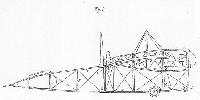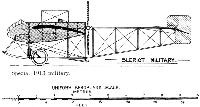L.Opdyke French Aeroplanes Before the Great War (Schiffer)
Deleted by request of (c)Schiffer Publishing
XXIX: Designed for military observation, this 2-seat side-by-side pusher monoplane was never built. The crew was forward in the nacelle, with the 70 hp Gnome at the rear, with outrigger structures on each side coming to a point and supporting a monoplane tail and an odd oval rudder set below it. A pair of large wheels was set under the leading edge, with a smaller pair on the skids forward. But similar designs would be built later. Among drawings dated 1912 are some of the same aeroplane but with the tail outriggers enlarged and brought together with the propeller turning inside and between them; these are marked XXIXbis.
XXXVII: This seems to have been a further development of the Type XXIX and XXIXbis, designed in January 1913. This time the pusher propeller turned on the top aft longeron outrigger; this, with the 2 lower longerons, supported a standard tail unit. The 2 crew sat forward, the nose of the nacelle hinging downward to allow them access. The centrally-mounted 80 hp Gnome was replaced with one of 100 hp, and after some 10 months of tests, the pilot Perreyon killed himself in it. (Although a photograph was probably shown at the Olympia show in London in February 1913, no single photograph seems to have survived.)
Jane's All The World Aircraft 1913
Special types of Bleriots.--Early in 1913 a special experimental military machine was produced with considerable secrecy.
Журнал Flight
Flight, February 15, 1913.
NEW 80-H.P. MILITARY GNOME-BLERIOT TWO-SEATER.
A NEW two-seater monoplane has been evolved from the Bleriot works at Levallois Ferret, and tested more or less secretly at Buc. In the rough side and front elevation sketches which we are able to reproduce this week, it will be seen that, in its lines, it is unlike any machine that has previously been turned out from these celebrated French works. The essence of the design is that the propeller is arranged to the rear of the body, so that the passengers, sitting in front of it, may have a perfectly clear view below, and in front of them. Arranged in this way, the machine becomes more capable of being used for offensive purposes than if the propeller revolved in front. Pilot and passenger are seated side-by-side in the front of the fuselage, while in front of them there is a windshield, which can be hinged forward so that they may have no difficulty in climbing in or out of the machine. Behind them are the fuel tanks and the 80-h.p. Gnome motor, the latter being supported on two bearings.
The body of the machine is really in two sections, the section which accommodates the passengers, the tanks and the motor, and that portion of the framework which carries the tail. This latter section is built up with three longitudinals, the upper one passing through the propeller-boss, an arrangement which is made use of on the 90-h.p, Grahame-White military biplane that is described elsewhere in this issue. A drawback to this method of arrangement is that if the propeller bearing ran hot, or if any vibration were set up owing to the propeller becoming damaged, it is likely that the upper member of the tail fuselage would become damaged and, maybe, lead to a collapse of the tail, with probably disastrous results. That the chances of an accident of this kind may be minimised, the propeller bearing of this new Bleriot monoplane carries an electric detecter, in circuit with a small bell near the pilot which warns him should any undue vibration be set up or should the bearing tend to overheat.
The two lower longitudinals of the fuselage extend forward, forming short skids which are intended to protect the nose of the machine in the event of a heavy landing. A modified version of the standard Bleriot landing gear is employed. Probably the most striking peculiarity of the machine is that the distinctive cloche control has been abandoned, and its place been taken by a vertical hand wheel. The rudder is still operated by the feet. Its main dimensions are a great deal bigger than the standard Bleriot machines existing at the present time, and it is expected that this new Bleriot military monoplane will have great things to show as regards weight lifting. It has a span of 12 metres and its overall length is 10.50 metres.





